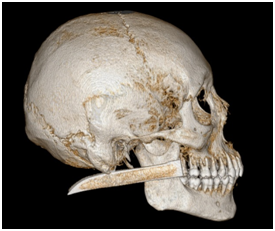MOJ
eISSN: 2381-179X


Case Report Volume 8 Issue 3
1Cirujano Oral Maxilofacial Adscrito al Hospital General “Dr. Darío Fernández Fierro” ISSSTE, Mexico
2Residente de tercer año Cirugía Maxilofacial, “Hospital Regional Lic, Adolfo López Mateos”, ISSSTE, México
3Universidad La Salle, Hospital Angeles Metropolitano, Mexico City, México
4Medical Doctor, Hospital General de Zona 30, IMSS, Mexico City, México
5General Estomatologist, Private Practice, México
6General Surgery Service, Hospital General de Zona1 Manuel de Mucha Macias, IMSS, Mexico City, México
7General Surgery Redident, Hospital Regional ISSSTE Dr. Manuel Cardenas de la Vega, Mexico
8Otorrinholaringology Resident, Centro Médico ISSEMYM, Mexico
Correspondence: Jorge Carrillo Rivera, Plaza Paseo Santa Mónica, Avenida Juárez número 8. Colonia las margaritas. 53618677. Consultorio 124. Tlalnepantla Estado de. México,
Received: January 01, 1971 | Published: June 27, 2018
Citation: Jorge CR, Stefan TGC, Raúl MG, et al. Stab wound in the facial region (Jael`s Syndrome), case report. MOJ Clin Med Case Rep. 2018;8(3):142-143. DOI: 10.15406/mojcr.2018.08.00260
Described by Jefferson in 1968, Jael's syndrome is described as an intentional injury caused by a knife in the skull or face. The clinical and radiographic diagnosis is essential to know the risk of damage to the anatomical structures and the location of the foreign body, treatment includes removal, wound examination, suture, tetanus immunization and antibiotic prescription. This article describes the clinical case of a male patient with knife wound with a foreign blade in the buccal, masseter and mastoid region and its surgical treatment.
Keywords: a knife wound, facial region, Jael's syndrome
There exist only a few cases reports in the literature about stab wound in the face with the presence of the blade included.1 Most of them were completed after an assault, street fight or work accident; the blade goes through the soft tissue producing damage to anatomic and vascular structures.2,3 The Jael syndrome has been used in the medical literature previously, based on the biblical passage about the murder of Sisera by Jael (Judas IV:21). The treatment is multidisciplinary, initially to secure the airway, complete the hemodynamic stabilization, neurologic, ophthalmologic and vascular evaluation.4 The imaging studies are fundamental to evaluate the location of the blade, direction, and relationship with adjacent anatomic and vascular structures, important in the area involved.2,4
A male patient of 58 years old come to the emergency room after being attacked by other persons with a knife in the facial region. A physical exam shows a Glasgow of 15 points, with a cutting wound in the right side of the mouth, with oral opening limitation, pain in 6 of 10 points in VAE. Lateral and posterior-anterior x-rays were performed, showing the knife blade in horizontal position with an anterior-posterior direction and related with soft tissue located in the ascending mandibular branch in the right side to the cervical posterolateral región and adjacent to the mastoid process (Figure 1).
A CT scan was performed with 3D reconstruction and vascular CT scan to locate the foreign body with respect to vascular structures (Figure 2).

Figure 2 3D reconstruction of CT scan where the position, direction, and relation with other anatomic structures were established.
The patient was moved to the operating room to complete the remotion of knife blade under general anesthesia. Using the same wound as the point of approach, and with previous confirmation of no affection to vascular vital structures, the knife blade was retracted without major bleeding, the wound washed and closed with polyglycolic acid in deep planes and nylon in the skin, without incidents or accidents (Figures 3) (Figures 4).
According to Nogueira de Barros et al., the indications for remotion of a foreign body in the facial region are that it is of organic origin, is freely palpated, is anterior to the orbit, have high toxicity, is in an intraarticular position, the presence of infection or limit the function. Within the contraindications for remotion reports the inorganic origin, location posterior to the orbit, proximal to vital structures, the absence of imaging studies, the risk of iatrogenic damage, the absence of symptoms or not precisely location.3
Shinohara recommends that the management of this cases with wounds with foreign bodies inside should be with an access, remotion of the foreign body, wound exploration, irrigation and suture, all this plus tetanic immunization and broad spectrum antibiotics.5
The stab wound in the facial region with the presence of the foreign body is a rare case with only a few reports in the literature.4,7
The lesions caused with sharp objects need a special attention, by the need of imaging studies with the 3D reconstruction of soft and hard tissues in the diagnosis. For all the lesions in the facial region a vascular CT scan, carefully physical exploration and careful management of anatomic structures, especially the airway, nerves, arteries, and veins are needed. The present case included antibiotics therapy with Amoxicillin with clavulanic acid, anti-tetanus vaccination and close control of the wound.
None.
Author declares no conflict of interests.

©2018 Jorge, et al. This is an open access article distributed under the terms of the, which permits unrestricted use, distribution, and build upon your work non-commercially.